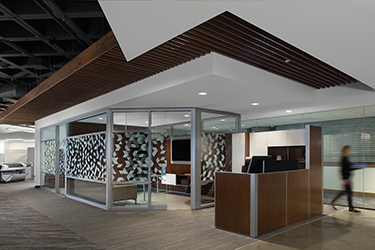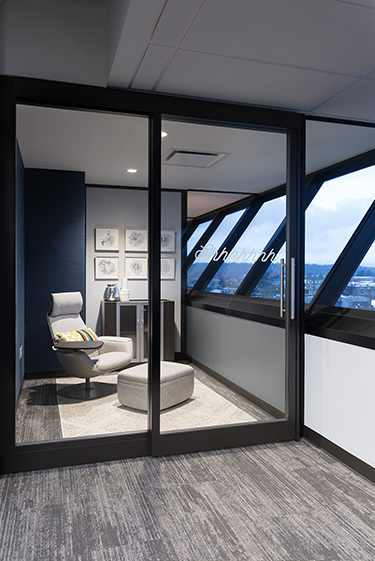|
Subscribe / Renew |
|
|
Contact Us |
|
| ► Subscribe to our Free Weekly Newsletter | |
| home | Welcome, sign in or click here to subscribe. | login |
Construction
| |

December 28, 2017
With cloaking walls and ideation hubs, this is probably not your father's office space
Special to the Journal
The ebb-and-flow of creativity drives today's workers to expect more from their office space, according to Jeff Rospond, president and CEO of OpenSquare, a Seattle firm that helps companies with design, furniture, fixtures and equipment logistics.
Gone are the days, Rospond said, when office workers spent 40-hour weeks sequestered in cubicles, with occasional trips down the hall to collaborate around a conference table.
“The work station cubicles are going away,” said Respond. “Sitting all day is the new smoking. The trend for office design is more activity-based, and there are a lot fewer private offices.”
Camilla Watson, an interior designer with ZGF Architects' Seattle office, said openness is now the norm.
“Workplace design has transitioned over the last several decades from traditional cubicle farms to modern, open offices,” said Watson. “As collaboration, innovation and wellness have become more important to the office culture of companies, they look to their interior environments to facilitate and inspire such activity. This means creating welcoming, high-performance spaces that serve as a framework for several different working styles and personality types.”
Modern work spaces combine the latest technology with the latest furniture design, and also encourage collaboration, with products such as Steelcase's V.I.A. walls, Rospond said. These glass walls keep out ambient noise and can provide privacy through “cloaking technology” that obscures digital screens to passersby.
OpenSquare designs offices that can have places like “focus studios,” “duo studios” and “ideation hubs.”
Focus studios are designed for one person, with chairs that allow a range of postures and AirTouch tables that move up and down. Duo studios have work tables for two people and electronic white boards — such as Microsoft's Surface Hub — for shoulder-to-shoulder creativity. An ideation hub can have round tables with stools, a digital screen and V.I.A. walls.
Rospond said OpenSquare's Puget Sound clients range from Fortune 500 companies to federal agencies and state universities.
“When we work with new clients, we want to understand where they want to go with their culture,” said Rospond. “Work space can be a fulcrum or reference point for how to shape a company's culture. We want to understand exactly what they're trying to achieve.”
He said OpenSquare has 26 designers and 18 project managers. The firm can do its own design, or work with other architects and interior architects. The company has a relationship with Steelcase office furniture, but also works with more than 300 furniture makers.
“We start by talking with the people who will work in the space,” said Rospond. “What is the work they do and why do they come together? We use that to influence what the design should be.”
Well before OpenSquare moves furniture into an office, the firm tries to collect data on how a company currently uses its space. Meeting rooms are equipped with sensors to monitor how many people come and go — to understand whether a room is being underutilized, Rospond said. Sensors can also be installed after spaces are re-designed to see what has changed.
OpenSquare does what Rospond called “life-cycle” projects — offering everything from design to furniture and moving services, as well as on-going support as companies grow and change.
Though the company began in the early 1930s as a furniture company, Rospond said over the years it expanded to include furniture reupholstering and ultimately design services.
“We help companies understand design trends, and prepare companies for changes that are about to come,” he said. “Change is scary for people, even if it is positive change.”
As a baby boomer, Rospond said he has his own preferences for technology: He uses a laptop, while millennials may be more inclined to use tablets.
The key is to accommodate different technology in one space. “In some cases, there are five generations of workers in the same office space,” he said.
Flexibility is key, Watson said. “A traditional one-size-fits-all approach has given way to providing flexible, transformational spaces for ad hoc meetings as well as indoor/outdoor social hubs that allow spontaneous interactions,” she said.
While mobile technology enables people to work remotely, Rospond said the most innovative office design encourages collaboration that can only be done when people work in the same space.
“If an employee works from home, they can become disconnected from the culture of the company because they are away from the office,” he said. “We want to create an innovative space that will allow people to do their best work, and allow companies to attract and retain the best talent. The work place is a critical component of that strategy.”
Previous columns:
- OSHA delays crane safety rules for another year; industry can comment, 12-21-2017
- Is the cladding on your building a fire hazard? Here's a new tool that can assess the risk, 12-14-2017
- If your high performance building isn't performing, try talking to the people inside, 12-07-2017
- Museum projects keep local AEC firms busy, but they don't expect that to last, 11-30-2017
- Crane guy says his material hoist system saves time and money; frees up elevator, tower crane, 11-16-2017
- Cargo containers no longer just for low-income or emergency housing — they've got ‘stylistic cachet', 11-09-2017
- Now is a great time to get trained for a career in construction: Here's why, 11-02-2017
- Developer says Bullitt Center inspired him to try high-end, very green apartments — and it worked, 10-26-2017




